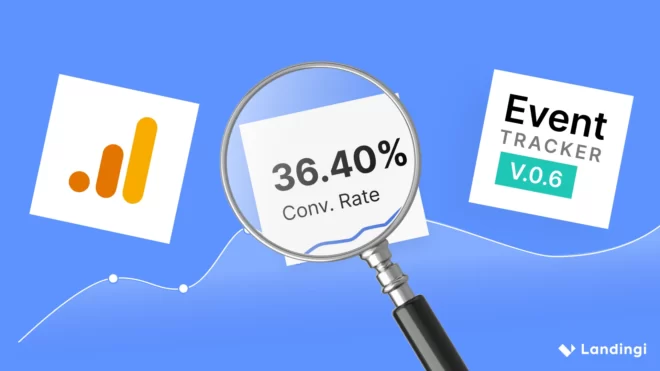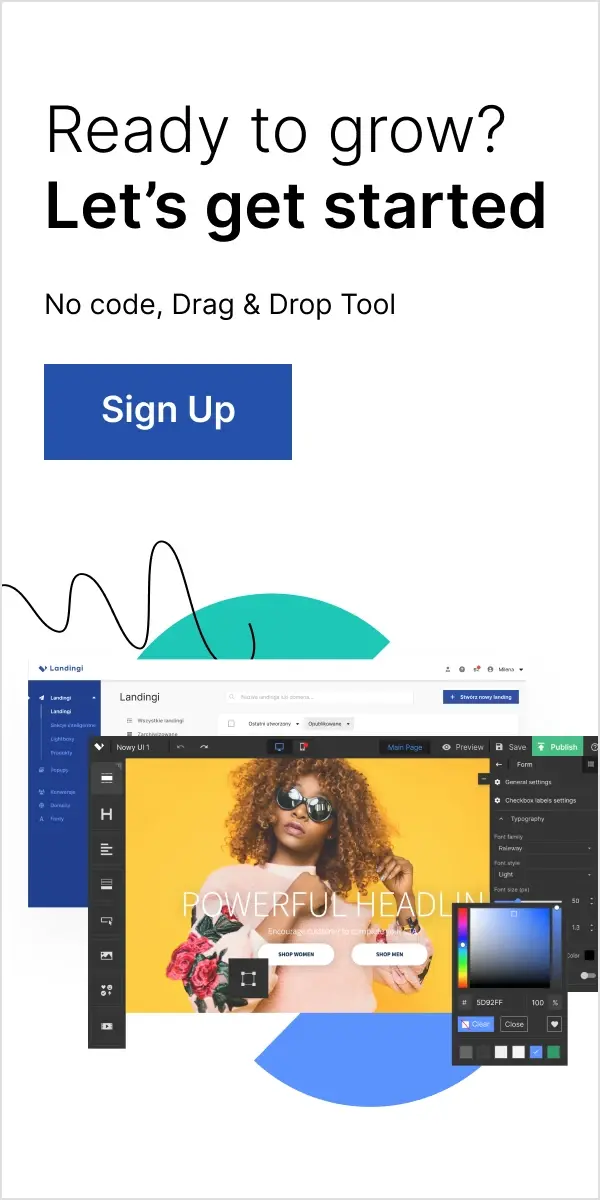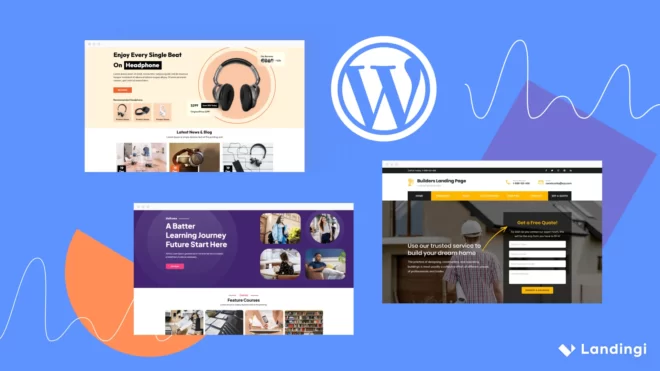Landing page tracking tools are designed to support digital marketing efforts in optimizing landing page-based campaigns. While the average landing page conversion rate is 2.35%, some landing pages achieve incredible results of even 80%. If you wonder, it is possible, as landing page success lies in ongoing, data-based optimization. This is where landing page tracking tools come into play, offering invaluable insight into user behavior, conversion rates, and overall page performance.
With the right tracking tool, you can better understand your target audience, A/B test different elements to see what works best, and ensure your landing pages perform at their highest potential.
In this article, we explore the top 6 landing page monitoring software options available today, highlighting their key features, strengths, and how they can fit into your digital marketing toolkit. The competition winner is EventTracker, a tailored solution provided by the best landing page builder – Landingi, to simplify complex conversion optimization processes.
Still, the digital marketing market provides plenty of powerful software invented to track and analyze website metrics. Whether you’re just starting out or looking to upgrade your current tools, this ranking will help you find the perfect tool to enhance your landing page performance and drive your marketing objectives forward.
Make your sections smartable and let go of mundane manual tasks with Smart Sections! An easy way to manage bulk changes.
1. EventTracker
The best landing page tracking tool is EventTracker by Landingi – a solution that perfectly supplements the landing page builder and excels in its comprehensive functionality. It allows you to track all interactions on a landing page across both desktop and mobile versions, including clicks, form submissions, video engagements, and more, without code. As it seamlessly integrates with the Landingi Dashboard, the tool enhances the user experience by automatically populating data in the Events tab.
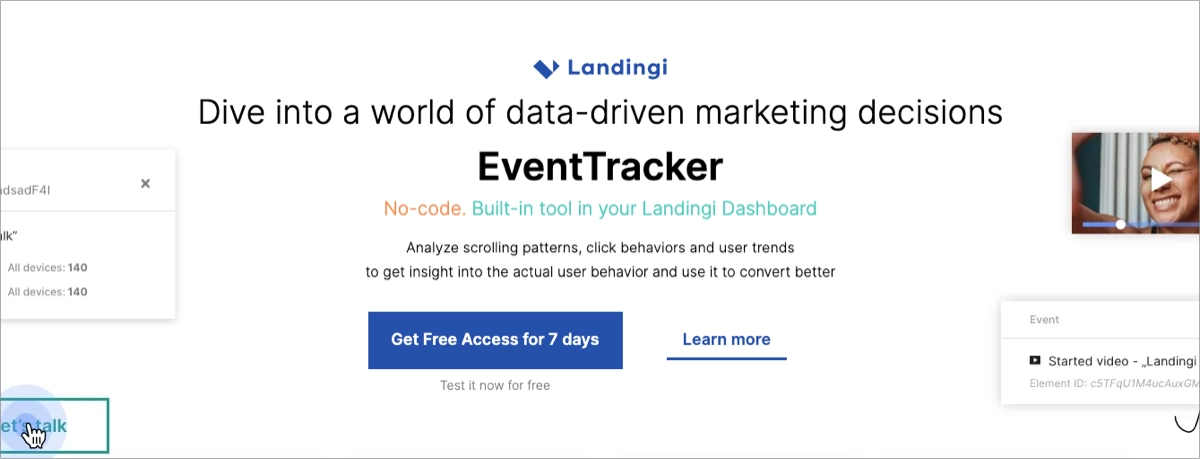
EventTracker doesn’t require advanced skills, making it a perfect choice for both beginners and experienced users. It’s designed with a user-friendly interface that requires no initial setup. After publishing your page, you can access EventTracker by choosing the Events tab in your Landingi Dashboard – the data appears with growing page traffic.
With EventTracker, you can track multiple landing pages, collecting data that involves the following areas:
- Clicks (buttons, images, icons)
- Forms (initiations, submissions, errors)
- Videos (starting, entirety watching)
- Leads (data from each form)
- Scrolls (data for 4 scroll depths: 25%, 50%, 75%, 90%)
- Checkouts (completed purchasing via PayPal, Stripe, or PayU buttons)
- Lightboxes (triggering and displaying)
All metrics are showcased in clear, customizable charts and tables – a new version of the tool also allows you to generate heatmaps, providing insightful data about user engagement and letting you better understand user behavior. You can also integrate EventTracker with Google Analytics 4, which allows you to automatically send all data to the GA4 Dashboard, enhancing your digital marketing toolkit.
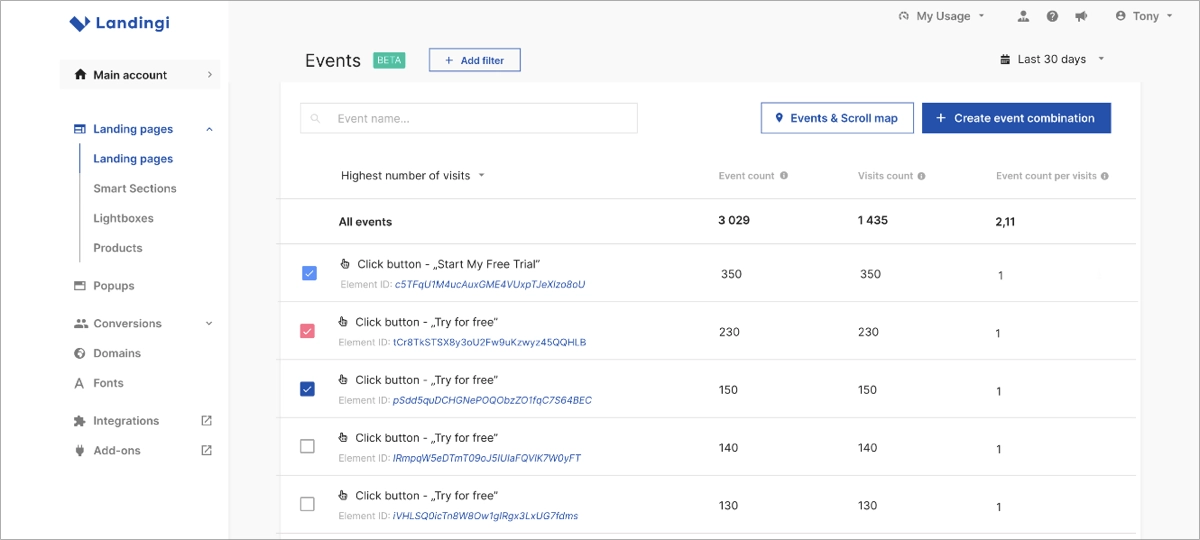
The analytics provided by Landingi are designed to be accessible even to those with little to no technical expertise. With visual dashboards and clear metrics, you can quickly identify which elements of your landing pages are performing well and which need adjustments. This immediacy in feedback allows for rapid iteration and optimization of landing pages, ensuring that every design choice is data-based.

By understanding user behavior through EventTracker’s analytics, you can make informed decisions that significantly enhance the user experience and, consequently, increase conversion rates. Thus, Landingi’s event-tracking solution not only simplifies the optimization process but also amplifies its effectiveness, helping you achieve your marketing objectives more efficiently.
Key takeaways – why to choose EventTracker:
- Price: 7-day free trial, paid plans from $40 monthly
- Ease of use: highly intuitive, no-code solution
- Integrations: Landingi add-on, Google Analytics 4, and more
- Analytics and reporting: user behaviors, interaction patterns, conversion triggers, A/B testing
- Support: Help Center; chat & e-mail: 100% human support, without chatbots or AI
- Security and compliance: highest standards in the definition of GDPR
2. Google Analytics 4
The second in the ranking of top landing page tracking tools is Google Analytics 4, distinguished by its event-based data model and predictive analytics features. This completely free tool offers a robust and comprehensive set of features that enable marketers to accurately assess their landing pages’ effectiveness.
GA4 allows for a deeper understanding of user behavior. It enables tracking specific interactions across websites and apps without any additional setup for most standard events. This level of detail provides insights into the user journey from first interaction to conversion, offering a holistic view of user engagement.
The new Google Analytics allows for more customization in reporting compared to previous versions. You can create and modify reports to match specific business needs, gathering better insights tailored to your goals and KPIs.
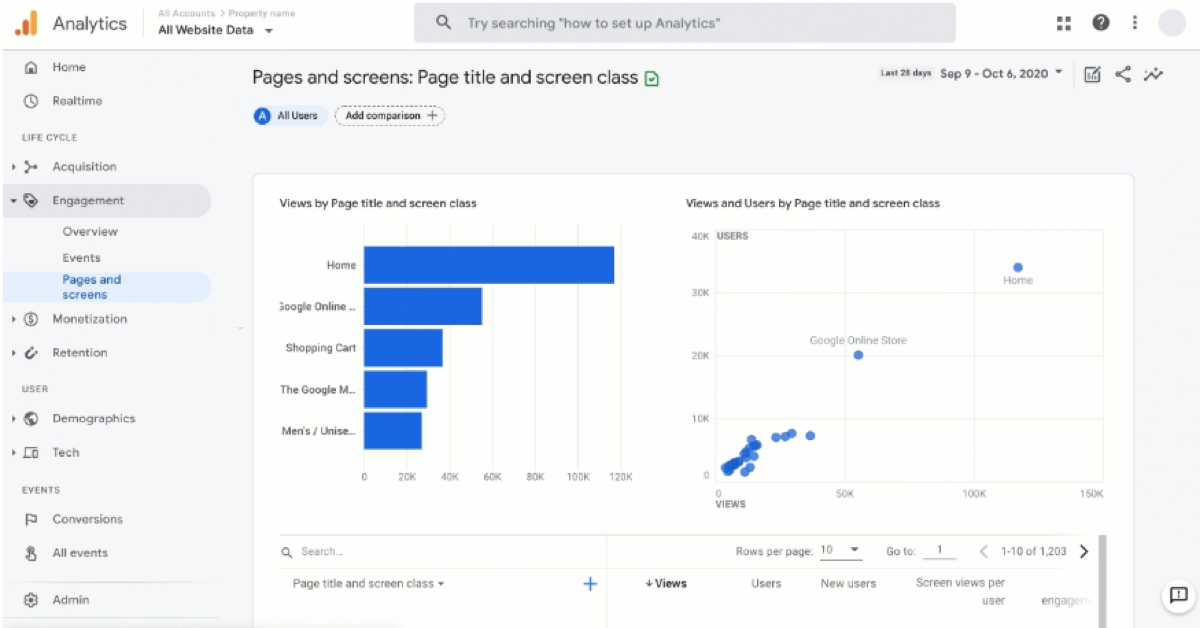
With GA4, tracking across devices and platforms simplifies, allowing you to follow users seamlessly across web and mobile interactions. This provides a unified view of how users interact with various landing page elements, from clicking a call-to-action button to filling out forms or watching promotional videos. All data are presented in clear charts, graphs, and tables.
The website analytics tool provided by Google excels in segmenting audiences based on their behavior, which is invaluable for personalized marketing campaigns. You can create custom audience segments based on specific interactions with a landing page, which can then be targeted with tailored messaging to increase the likelihood of conversion.
Key takeaways – why to choose Google Analytics 4:
- Price: free
- Ease of use: requires some experience
- Integrations: Google Ads, YouTube, and more
- Analytics and reporting: customizable event tracking, predictive analytics features
- Support: Analytics Help; Users Community help; Helpline,
- Security and compliance: standards in the definition of GDPR and CCPA
3. Open Web Analytics
The third in the ranking of top landing page tracking tools is Open Web Analytics, which allows for detailed monitoring and analysis of websites and applications and supports popular platforms like WordPress. OWA is a free, open-source solution that can be run under your domain or integrated directly into your web applications. This versatility makes it a top choice for developers and marketers who need a customizable and deeply integrative tool.
Despite its powerful features, OWA maintains a user-friendly interface accessible even to those with limited technical knowledge. It provides an intuitive setup process and straightforward tools for viewing and interpreting data, making it easy for users to start tracking and analyzing their web traffic without much learning effort.
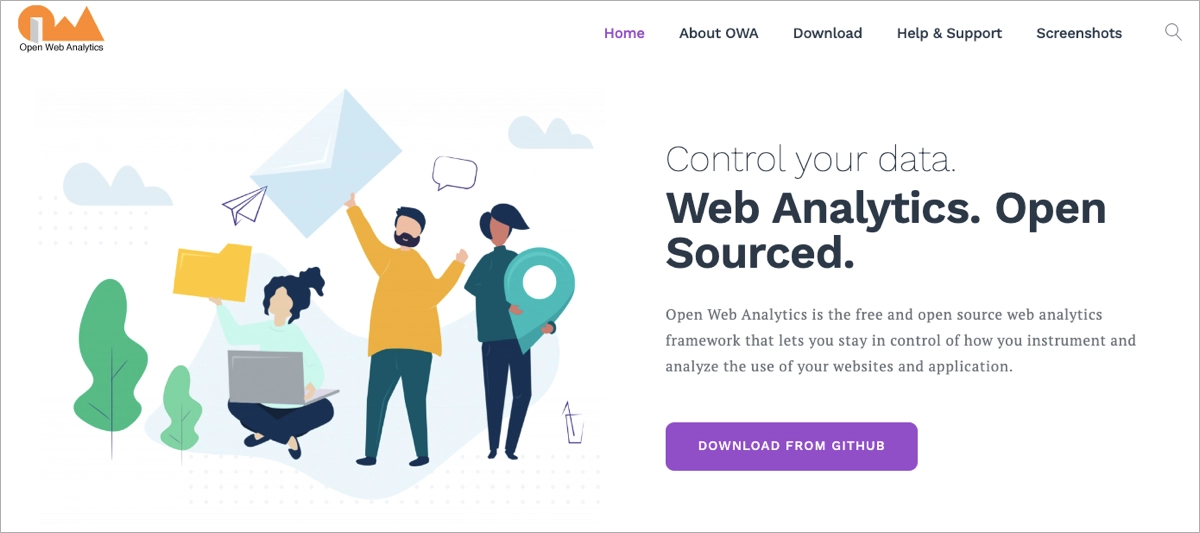
OWA is a great choice if you are looking for comprehensive analytics and detailed reporting capabilities. It offers a variety of standard metrics, dimensions, and reports, along with advanced features like:
- heatmaps,
- clickstream analysis,
- detailed usage statistics,
for tracking individual web pages. These tools provide deep insights into user behavior and site performance.
As an open-source tool, OWA represents exceptional value, offering capabilities similar to those of premium analytics services without the associated costs, making it an excellent option for businesses of all sizes looking to maximize their analytics budget.
Key takeaways – why to choose OWA:
- Price: free, open-source solution
- Ease of use: intuitive yet requiring technical knowledge
- Integrations: open-source tool capabilities
- Analytics and reporting: user behaviors, standard metrics
- Support: Users and Developers’ Community help
- Security and compliance: standards in the definition of GDPR
4. Hotjar
The fourth in the ranking of top landing page tracking tools is Hotjar, which focuses strongly on visualizing user behavior through heatmaps, session recordings, and conversion funnels. By allowing you to see not just where users click but how they scroll, move, and depart from a page, Hotjar provides a deeper insight into how users interact with landing pages.
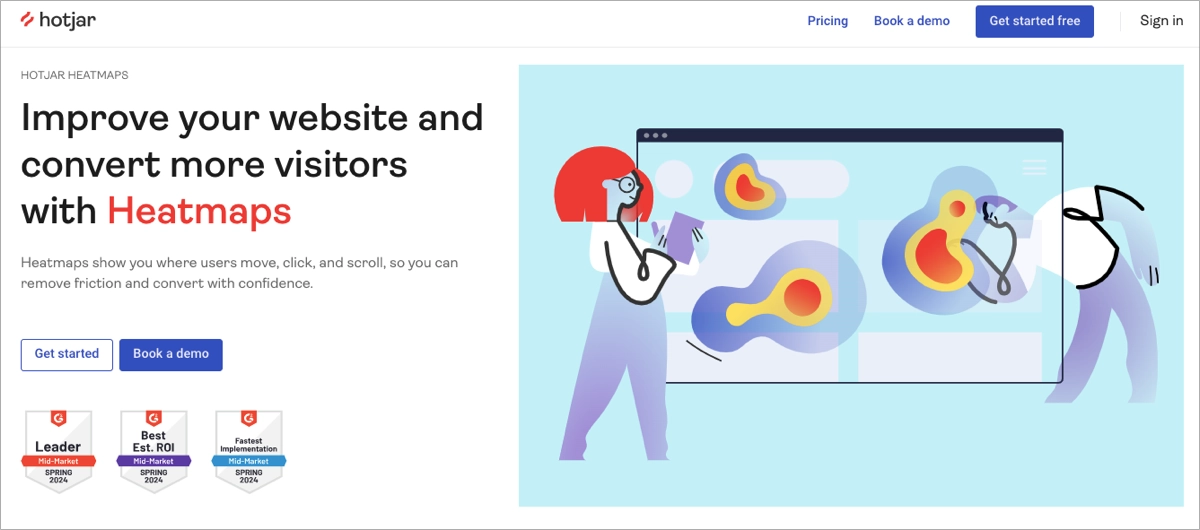
Hotjar is designed with usability in mind, featuring a user-friendly interface that makes complex data approachable for everyone. With visual heatmaps and intuitive dashboards, you can easily interpret data without needing a data analysis background. It makes Hotjar accessible to smaller teams or individual marketers, even those without technical experience.

Hotjar also provides side features that allow gathering user feedback through surveys and satisfaction ratings. It’s another important part of landing page optimization and evaluating the target audience’s needs, which you can cover with this multifunctional tool. Moreover, Hotjar enables integrations with many popular digital marketing platforms, giving you a great opportunity to create your perfect mar-tech toolkit.
Key takeaways – why to choose Hotjar:
- Price: free Basic plan; paid plans from €32; full–access plan from €171 monthly
- Ease of use: intuitive, with user-friendly visual data reporting
- Integrations: extensive capabilities
- Analytics and reporting: heatmaps, user interactions, user feedback
- Support: Help Center; Request Form
- Security and compliance: standards in the definition of GDPR
5. VWO
The fifth position in the top landing page tracking tool ranking takes VWO, thanks to delivering comprehensive behavioral analytics and A/B testing tools. VWO is recognized for its user-friendly interface that simplifies web testing and analytics complexities. It integrates seamlessly with other marketing tools and analytics software, enhancing its utility for comprehensive campaign management.
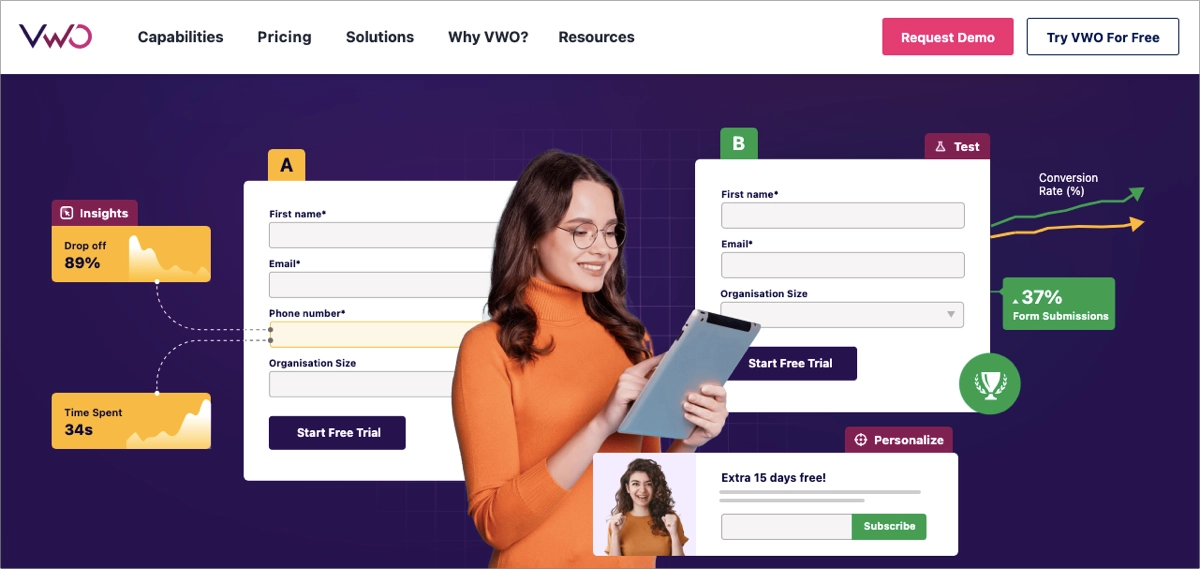
VWO provides detailed analytics that help understand how different landing page elements perform. The platform offers insights into user behavior, conversion metrics, and the effectiveness of specific tests, all visualized through intuitive reports covering the following areas:
- session recordings,
- heatmaps,
- surveys,
- forms,
- funnels,
- segments.
VWO, with features like visual editing and easy test setup, makes the optimization process accessible even to those without deep technical expertise. Its pricing model is designed to offer flexibility, catering to businesses of all sizes with various pricing tiers based on features and scale.
Key takeaways – why to choose VWO:
- Price: 30-day fully featured free trial; entirely free with 5k MTU; paid plans from $171 monthly
- Ease of use: intuitive
- Integrations: automated integrations, API
- Analytics and reporting: user behaviors, user feedback, heatmaps
- Support: Knowledge Base, Support
- Security and compliance: standards in the definition of GDPR and CCPA
6. Piwik Pro
The sixth in our top landing page tracking tools ranking is Piwik Pro, a solution that supports detailed tracking across various digital platforms, including web and mobile. It’s designed to be user-friendly, with a clean interface that makes navigation and data interpretation straightforward. It also provides drag-and-drop features for creating custom reports – you can customize the dashboard to display the most relevant data.
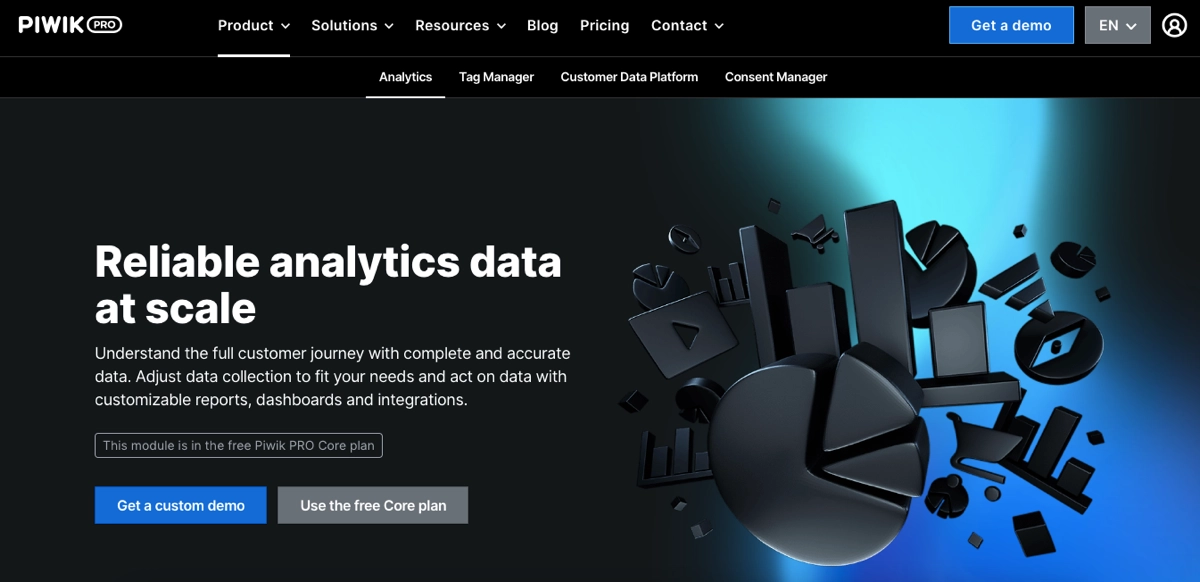
Piwik Pro stands out with its robust analytics capabilities, offering detailed reports on visitor behavior, traffic sources, bounce rates, and much more. It provides real-time data updates, allowing you to react promptly to user behaviors on your landing pages. Advanced segmentation and filtering capabilities enable deeper insights into specific user groups or campaign performances.
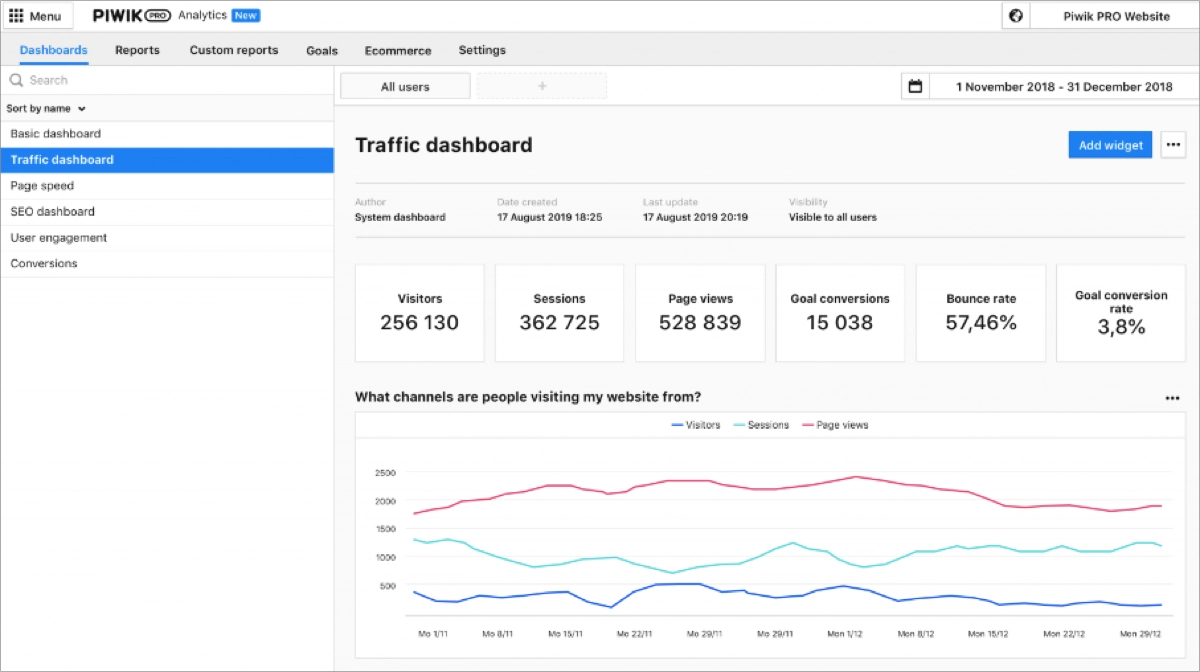
Piwik Pro integrates well with existing IT and data management infrastructures, providing APIs and SDKs for customization and automation. This enables you to tailor the analytics to your specific needs. The tool strongly focuses on privacy and compliance with international data protection laws, offering full data ownership and doesn’t rely on third-party data processing, which is a significant advantage for those prioritizing data security and privacy.
Key takeaways – why to choose Piwik Pro:
- Price: free Core plan, Enterprise plan from the annual price of €10,995
- Ease of use: user-friendly interface,
- Integrations: Google Ads and others, API, SDK
- Analytics and reporting: user behaviors, funnel analysis, reporting on large data sets
- Support: Help Center; Community Forum; Dedicated Support for Enterprise customers
- Security and compliance: highest standards in the definition of GDPR, LDPR, TTDSG and CNIL
FAQ – Landing Page Tracking tools
Get to know more about landing page monitoring and find answers to the most frequently asked questions about tracking software – prepare yourself and start data-based optimization targeting your marketing efforts to build an effective landing page that converts.
What Are Landing Page Tracking Tools?
Landing page tracking tools are software solutions designed to monitor and analyze the performance of landing pages. They provide insights into visitor behavior, conversion rates, and the overall effectiveness of the landing page in achieving its intended goals. Landing page monitoring tools can be classified by function as follows:
- Analytics and reporting – tools designed to track visitor data, such as page views, user engagement time, bounce rates, and conversions.
- Conversion tracking – tools designed to track actions taken on a landing page, such as form submissions, downloads, or sales, providing data on what percentage of visitors complete a desired action.
- A/B testing – tools that offer A/B testing capabilities, allowing marketers to test different page versions to see which performs better and to optimize key page elements such as headlines, CTA buttons, images, and overall layout.
- Heatmaps and user behavior – tools that provide heatmaps, scroll maps, and other visual representations of where visitors click, move, and scroll on a page.
How Do Landing Page Tracking Tools Work?
Landing page tracking tools operate through a combination of data collection, analysis, and visualization to give you valuable insights into the performance of your landing pages. These tools generally involve 5 crucial areas, as follows:
- Data collection
The data collection process is possible by installing tracking codes provided by the tracking tool on the landing page. When a visitor lands on the page, this code collects various data types, such as the visitor’s IP address, device type, browser, time spent on the page, and actions taken (like clicks or form submissions).
- Data analysis
The data analysis process extracts meaningful insights. This can show trends over time, such as increases or decreases in traffic, improvements in conversion rates, or changes in visitor behavior patterns. Tools may also segment data based on user demographics, source of traffic (organic, paid, referral), and other criteria to provide more granular insights.
- A/B testing
Tracking tools that allow users to conduct A/B tests, where different versions of a page are shown to various segments of visitors, track each version’s performance metrics to determine which achieves better engagement and conversion rates, giving full insight into key metrics.
- Reporting and visualization
The data are compiled into reports and dashboards that are easy to understand. These reports can include graphs, charts, heatmaps, and more, visually representing how visitors interact with the page. Metrics such as bounce rate, conversion rate, and average session duration are commonly displayed to help users assess page performance quickly.
- Real-time monitoring
Some advanced tools offer real-time monitoring, which provides immediate data on how changes to a landing page affect user behavior. This feature is handy for high-traffic campaigns where immediate feedback is crucial for optimizing performance.
What Metrics Can Be Tracked with Landing Page Tools?
Landing page tracking tools can monitor traffic volume, conversion rate, bounce rate, and various metrics that provide insights into the performance and effectiveness of a landing page. The most common landing page metrics tracked by dedicated tools involve the following:
- Traffic volume – the number of visitors to the landing page, often represented as two metrics, unique visitors and repeat visitors, to give a clearer picture of the page’s reach and audience engagement.
- Bounce rate – the percentage of visitors who leave the site after only viewing it. High bounce rates indicate that the page is not engaging enough or relevant to the visitors’ expectations.
- Conversion rate – the most critical metric, showcasing the percentage of visitors who complete a desired action on the page, such as filling out a form, signing up for a newsletter, or purchasing. This metric directly relates to the landing page’s effectiveness.
- Average time on page – shows visitors’ average time on a landing page before leaving. Longer times suggest more adequate and engaging content, while shorter times indicate a lack of engagement or relevance.
- Page views per visit – tracks how many pages a visitor views after entering through the landing page. It helps determine how effectively the page encourages further exploration of your site.
- Traffic sources – shows where your traffic comes from (e.g., organic search, paid ads, social media, direct visits). It helps understand which channels drive users to the landing page most effectively.
- Lead generation – involves monitoring form submissions and how they convert into leads. It’s a crucial metric for landing pages specifically designed for lead capture.
- Form abandonment – the number of visitors that begin to fill out a form and don’t complete it.
- Click–through rate – the percentage of individuals viewing a web page who click on specific links to other page parts. It indicates how compelling your visitors find the content or offers presented.
- Heatmaps – show where visitors click, move their mouse, and scroll on the page, providing insights into user behavior and interaction with page elements.
- Scroll depth – the percentage of content length seen by visitors. It shows how far visitors scroll your page, indicating engagement and relevance of content.
- Device and browser performance – shows device and browser performance trends. It helps identify if there are technical issues affecting the user experience on specific platforms.
How Can Landing Page Tracking Tools Improve Conversion Rates?
Landing page tracking tools can improve conversion rates by providing deep insights into user behavior and the effectiveness of various page elements. They affect several areas of conversion optimization, as follows:
- Behavioral insights through analytics – tracking tools analyze how visitors interact with the landing page, providing data on where they click, how long they stay, and when they exit the page. This information is crucial for understanding what captures interest and what may cause visitors to leave without converting.
- A/B testing for optimization – one of the most powerful features of landing page tracking tools is the ability to run A/B tests. This allows marketers to compare different versions of a page to see which elements perform best based on data.
- User experience improvement – tracking tools can guide optimizations that enhance the overall user experience by identifying the areas of a landing page that receive the most engagement and those that lead to drop-offs.
- Personalization and targeting – tracking tools help segment visitors based on their behavior, traffic source, device used, and other demographics. This segmentation enables the creation of more personalized landing pages that cater specifically to the needs and preferences of different user groups, thus increasing the likelihood of conversion.
- Bounce rates reducing – tracking tools help to understand why users might be leaving the page quickly, delivering insights on changes that can be made to engage visitors longer and guide them towards conversion.
- Form fields optimization – tracking tools can show which fields are causing visitors to abandon the form, allowing for data-based form fields adjusting to reduce friction and increase the rate of form submissions.
- Page load speed enhancement – tracking tools also monitor the loading time of a landing page and inform when to optimize this factor to enhance user experience, positively affect SEO, and keep potential customers from leaving due to impatience.
- Heatmaps for visual insights – heatmaps, as specialized tracking tools, provide a visual representation of where users are most active on a landing page. This helps focus attention on optimizing the parts of the page that receive the most interaction, potentially increasing conversion effectiveness.
Are There Any Free Landing Page Tracking Tools?
There are plenty of free landing page tracking tools, like Google Analytics 4, Piwik, Hotjar, Clicky, Crazy Egg, or EventTracker – some of them, like GA4, are entirely free of charge, others, like Clicky, offer limited free plans, and some, like EventTracker or Crazy Egg, are available in free trial versions allowing to check their features without investing money before trying them out.
Free and comprehensive landing page tracking tools exist and can help marketers and website owners monitor and optimize their landing pages without investing in premium software. Accessing free trials is also a great option, as it allows you to check the possibilities of various solutions and choose the one that fits your needs.
Get 111 Landing Page Examples—The Ultimate Guide for FREE
How to Integrate Landing Page Tracking Tools with Existing Marketing Platforms?
To integrate landing page tracking tools with existing marketing platforms, check your chosen tool’s automated integration availability – the most popular tools have huge integration possibilities that answer your needs when creating a professional digital marketing toolkit.
For more personalized requirements, check if the chosen tracking tool allows integration with Zapier, the biggest integration hub that can connect tracking software with other platforms.
Most marketing platforms and tracking tools support API integrations. APIs (Application Programming Interfaces) allow different software systems to communicate. Check the documentation for your tracking tools and marketing platforms to understand how to set up these integrations – it’s a way to create a specific integration if an automated one for your tools isn’t available.
What Privacy Considerations Should Be Taken into Account with Landing Page Tracking?
The key privacy considerations to keep in mind when employing landing page tracking tools include the following:
- Compliance with legal frameworks – ensure your tracking practices comply with relevant data protection laws such as the General Data Protection Regulation (GDPR) in Europe, the California Consumer Privacy Act (CCPA) in the U.S., and other regional data protection laws. These regulations often require specific measures like obtaining consent before collecting personal data and providing clear information about what data is collected and how it will be used.
- User consent –obtain explicit consent from visitors before tracking their behavior on your landing pages. This can be managed through consent banners or pop-up messages that inform users about the cookies and tracking technologies being used and give them the option to accept or reject non-essential tracking.
- Transparency in data collection – inform your users about the type of data you are collecting, why you are collecting it, and how it will be used. This information should be easily accessible, ideally through a well-structured privacy policy linked directly from the landing page.
- Secure data storage and transmission – ensure that any data collected through landing page tracking is securely stored and transmitted. Use encryption methods to protect data in transit and ensure that your storage solutions comply with industry standards for security.
Moreover, you should always respect user preferences, anonymize data wherever possible, educate your audience about the importance of data collection in enhancing user experience, and regularly review your tracking tools and practices to ensure they comply with new and existing laws.
How to Analyze Data from Landing Page Tracking Tools?
To analyze data from landing page tracking tools effectively, begin by setting clear objectives, then collect data, segment it, and analyze the following areas:
- User behavior – look for patterns such as where users click most, how far they scroll, and where they spend the most time. This can help identify what attracts attention and what areas might be causing confusion or disinterest.
- Evaluate conversion funnels – if your landing page is part of a conversion funnel, analyze how users move through it. Identify which stages users drop off and try to determine why. This can involve looking at user flows and exit pages and performing cohort analysis to see how different user groups behave.
- Measure performance against KPIs – compare your findings against key performance indicators (KPIs) like bounce rate, conversion rate, average session duration, and CTR on key elements like CTA buttons. This will help you gauge the landing page’s success in meeting your set objectives.
- Perform A/B testing – use insights gained from initial data analysis to test different versions of your landing page. Change one element at a time (such as the headline, form, CTA, images, or layout) and measure how each variation performs regarding your KPIs. This helps in optimizing the page based on actual user data.
- Check for technical issues – analyze page load times, mobile responsiveness, and browser compatibility data. Technical issues can significantly affect user experience and page performance, so it’s important to identify and rectify these problems.
- Implement changes and monitor results – based on your analysis, implement changes to your landing page. Monitor how these changes affect performance, and be prepared to make further adjustments as needed.
- Use predictive analytics – if available, use predictive analytics to forecast future behaviors based on historical data. This can help in proactive decision-making for landing page optimizations.
Can Landing Page Tracking Tools Help with A/B Testing?
Landing page tracking tools can significantly aid in conducting A/B testing, which is a crucial method for optimizing the effectiveness of landing pages, leading to better user experiences and higher conversion rates. These tools automate many of the technical processes involved in setting up and running tests and provide in-depth insights that can guide more informed marketing strategies. It covers the following areas:
- Setup and implementation – most advanced landing page tracking tools come with built-in features to easily set up A/B tests.
- Traffic segmentation – these tools can automatically divide your site’s traffic between the different page variants to ensure each version receives a random yet statistically significant sample of visitors.
- Data collection – the tracking tool collects data on user interactions with each version of the page. This includes metrics like visit duration, bounce rate, conversion rate, and specific interactions like clicks on a CTA.
- Performance analysis – tracking tools analyze the collected data and compare the performance of each version against the others. They let you monitor these results in real-time and often include statistical significance calculators.
- Result visualization – tracking tools usually offer intuitive dashboards that visualize the results of A/B tests in charts, tables, or heatmaps, making it easier to understand differences in performance between page variants.
- Insights and recommendations – some advanced tools explain why one variant outperformed another. They might suggest further tests or pinpoint elements that significantly impact user behavior.
- Iterative testing – A/B testing is not usually a one-off; it’s an iterative process where initial tests lead to further hypotheses and subsequent tests. Landing page tracking tools streamline this process by making it easy to tweak existing tests or set up new ones based on accumulated data and insights.
Track Your Landing Pages with EventTracker
By using landing page tracking tools, you can scientifically optimize your landing pages, leading to better user experiences and higher conversion rates. These tools not only automate many of the technical processes involved in setting up and running tests but also provide deep insights that can guide more informed marketing strategies.
While each tool offers unique benefits suitable for different needs – from startups to large enterprises –EventTracker by Landingi emerges as the top recommendation. It distinguishes itself with its seamless integration capabilities, intuitive dashboard, and comprehensive tracking features that offer standard analytics and advanced functionalities like event tracking, conversion paths, and A/B testing.
Try EventTracker now and turn your casual page into a powerful digital marketing tool with Landingi.

